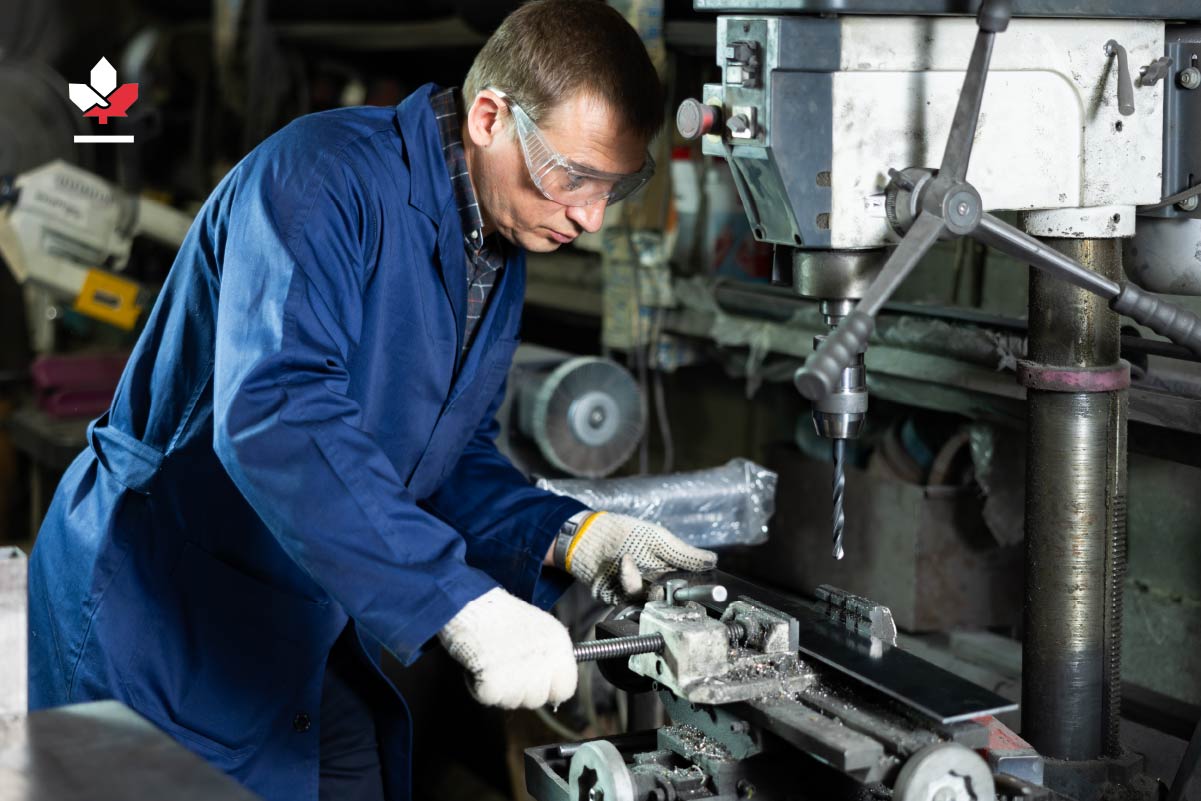How to Move to Canada as a Machinist
September 2, 2024
|
If you are a machinist looking to move to Canada, a land of vast landscapes and abundant opportunities, then you are among many skilled tradespeople worldwide who view it as a dream destination. Being a machinist in Canada offers a promising future if you want a fresh start or career advancement as a machinist. With a strong manufacturing sector and a growing demand for qualified professionals, Canada offers many immigration pathways if you want to capitalize on the steps required to become a machinist in Canada.
Want to learn how to move to Canada as a Machinist? Then, take a look at how to successfully relocate to Canada as a machinist and find job opportunities.
Does Canada Need Machinists?

Canada's manufacturing sector faces a critical need for skilled machinists due to ongoing industrial growth and technological advancements. According to the Canadian Manufacturers & Exporters (CME), the sector's expansion has created a significant skills gap, with a projected shortage of over 60,000 workers by 2025. Machinists are pivotal in producing precision parts and maintaining machinery essential for aerospace, automotive, and energy industries.
Advancements in automation and computer numerical control (CNC) technology require machinists to possess advanced technical skills. This demand is further underscored by the aging workforce and retirement rates, highlighting the urgency for targeted training programs and educational initiatives to address this shortfall and support Canada's economic development.
According to Canada's Job Bank, machinists are in demand in the following Canadian provinces or territories, with National Occupational Classification (NOC) codes and annual average salaries.
| Most In-demand Jobs | Annual Average SalarIes (CAD) |
|---|---|
| Alberta | 97,331.79 |
| British Columbia | 89,455.28 |
| Saskatchewan | 78,922.87 |
| Ontario | 75,896.43 |
| Nova Scotia | 74,589.91 |
How Can I Move to Canada as a Machinist?

Here are the steps to move to Canada as a machinist.
Step 1: Assess Your Eligibility
The first step in your immigration journey to Canada is determining your eligibility. To immigrate as a machinist, you must meet specific criteria, including the following.
- Age: Being under 45 years old
- Education: Have a minimum of a high school diploma or equivalent qualification verified via an Educational Credential Assessment (ECA) from a recognized organization like the World Education Services (WES),
- Work experience: Possess at least one year of full-time work experience in a relevant field, such as machining or metalworking,
- Language proficiency: Demonstrate proficiency in English or French, often measured through standardized tests like the International English Language Testing System (IELTS) or Canadian English Language Proficiency Index Program (CELPIP), and
- Adaptability: Show your ability to adapt to Canada's culture and social environment.
Step 2: Gather Required Documents
Once you have determined your eligibility, you must gather essential documents. This may include:
- Passport: A valid passport,
- Educational certificates: Copies of your diplomas or degrees,
- Work experience letters: Letters from previous employers verifying your work history,
- Language test results: Scores from your English or French language proficiency tests,
- Medical examination: A medical certificate confirming your good health,
- Police clearance certificates: Police clearance certificates from all countries where you have lived for a significant period.
Learn more using the Canadian immigration document checklist.
Step 4: Create an Express Entry Profile
Express Entry is a federal immigration program that manages applications for skilled trades workers, including machinists. You must create an Express Entry online profile, providing details about your education, work experience, language skills, and other relevant information. The most suitable Express Entry program for machinists is the Federal Skilled Trades Program (FSTP), an immigration pathway designed by Immigration, Refugees, and Citizenship Canada (IRCC) to attract skilled tradespeople who want to settle in the country permanently.
Step 5: Secure a Job Offer
While not always required, obtaining a job offer from a Canadian employer can significantly boost your chances of immigrating to Canada. You can actively search for a job in Canada through online job platforms such as Eluta or Glassdoor Canada, job fairs like FABTECH Canada or Canadian Mining Expo, or contact Canadian companies directly.
Learn more about the steps to finding a job in Canada.
Step 6: Receive an Invitation to Apply (ITA)
Based on your Express Entry profile and the Comprehensive Ranking System (CRS), you may receive an Invitation to Apply (ITA). This means you're eligible to submit a complete immigration application.
Learn how to secure an ITA for Express Entry to Canada.
Step 7: Submit Your Application
When you receive an ITA, you will have a specific timeframe for submitting your application. This includes providing additional documents and completing any necessary medical or background checks. When submitting your application, make sure you pay the required application fee of 1,525 CAD.
Learn how to submit the best Express Entry application.
Step 8: Prepare for Arrival
Once your application is approved, you will receive a permanent residence visa. Before your departure, you must arrange your move, such as finding accommodation, opening a bank account, and arranging transportation.
Learn how to prepare for your arrival using the ultimate checklist before moving to Canada.
What Does Canada Offer Machinists?

With a strong manufacturing sector and a growing demand for qualified professionals, Canada presents many opportunities for those with machining expertise.
Opportunities for Advancement
Canada offers ample opportunities for machinists to advance their careers. With ongoing training and development programs, you can acquire new skills and knowledge, leading to promotions and increased responsibilities. The country's diverse manufacturing landscape also provides opportunities to specialize in machining, such as CNC, tool and die making, or industrial maintenance.
Supportive Environment
Canada is known for its welcoming and inclusive culture. As a machinist in Canada, you will likely find a supportive environment where your skills and contributions are valued. Canadian workplaces often prioritize employee well-being and work-life balance, creating a positive and fulfilling work experience.
Continuous Learning
The manufacturing industry constantly evolves, and machinists must stay up-to-date with the latest technologies and techniques. Canada offers numerous opportunities for continuous learning, including workshops, conferences, and online courses. By investing in your professional development, you can remain competitive and adapt to the changing demands of the industry.
Among the prominent designated learning institutions (DLIs) where you can continue your education as a machinist are Saskatchewan Polytechnic, Northern Alberta Institute of Technology (NAIT), and Québec métiers d'avenir.
Strong Social Safety Net
Canada is known for its robust social safety net, providing its citizens high security and support. Administered by Employment and Social Development Canada (ESDC) and accessed via a Social Insurance Number (SIN), these benefits include affordable healthcare, education, and social services. As a machinist living in Canada, you can have peace of mind knowing that you and your family are well-protected in case of illness, injury, or other unforeseen circumstances.
Learn how to apply for a Social Insurance Number (SIN).
Now that you are equipped with the steps to immigrate to Canada as a machinist, you can begin your journey to become a Canadian machinist with the assistance of a Regulated Canadian Immigration Consultant (RCIC).
FAQs
How Long Does it Take to Get a Canadian Citizenship Certificate?
The processing times for a Canadian citizenship certificate can vary depending on several factors, including the volume of applications and the completeness of your submission. However, receiving your certificate may take around five to eight months.
Can My Family Accompany Me to Canada?
Your family can generally accompany you to Canada if they meet the specific eligibility criteria. This typically includes your spouse or common-law partner, dependent children, and sometimes other family members. However, the exact requirements may vary depending on your immigration status and the type of visa you are applying for.
What Should I Know About Living And Working Conditions for Machinists in Canada?
Machinists in Canada generally enjoy competitive salaries and benefits and a stable job market. The specific working conditions may vary depending on your company and industry, but you can expect a good work-life balance and opportunities for professional development.
